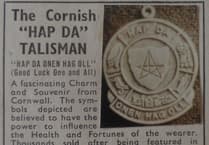DURING a recent visit to the Story of Emily Museum in St Ive, I noticed that just one clock on display had been manufactured locally.
The long case clock that stands on the first-floor landing of The Rectory, made by Peter Hitt of Liskeard. Another of Hitt’s clocks can be seen in the Royal Cornwall Museum, Truro; on the information card is ‘Pine-cased two-train cottage clock with 30-hour bird-cage movement made by Peter Hitt of Liskeard (1748-1803); cleaned and restored by A R Williams of Plymouth Clock Centre’. Letters of Administration were granted on October 7, 1803, to his widow, Mary Pitt of Liskeard.
More of Hitt’s clocks come to light occasionally; ‘an 18th century Cornish long case clock by Peter Hitt of Liskeard with 10-inch brass square dial and 8-day movement in a later mahogany traditional style case’ was auctioned in Truro on March 15, 2013. But his most interesting clock was subject to a three-page article in the June 2000 issue of ‘Clock’ magazine, and concerned the engraving of ‘P Hitt, Liskeard’ on the clock face.
‘Evidently the person who did this engraving wasn’t a skilled or well-practised engraver (or maybe he had too many glasses of beer with his lunch?). If you follow the engraving around starting with the maker’s name, it becomes apparent that the spacing between the letters becomes progressively smaller. Now, by the time engraver got to the town name he knew that there might be a problem! However, he bravely carried on, it is only when he got to the K of Liskeard that he knew things weren’t going to plan. If you look at the photograph of the dial, note that the last letter, D of Liskeard, sits as a small, neat addition above this word’.
By Brian Oldham, Liskeard Museum volunteer and Bard of the Gorsedh Kernow




Comments
This article has no comments yet. Be the first to leave a comment.